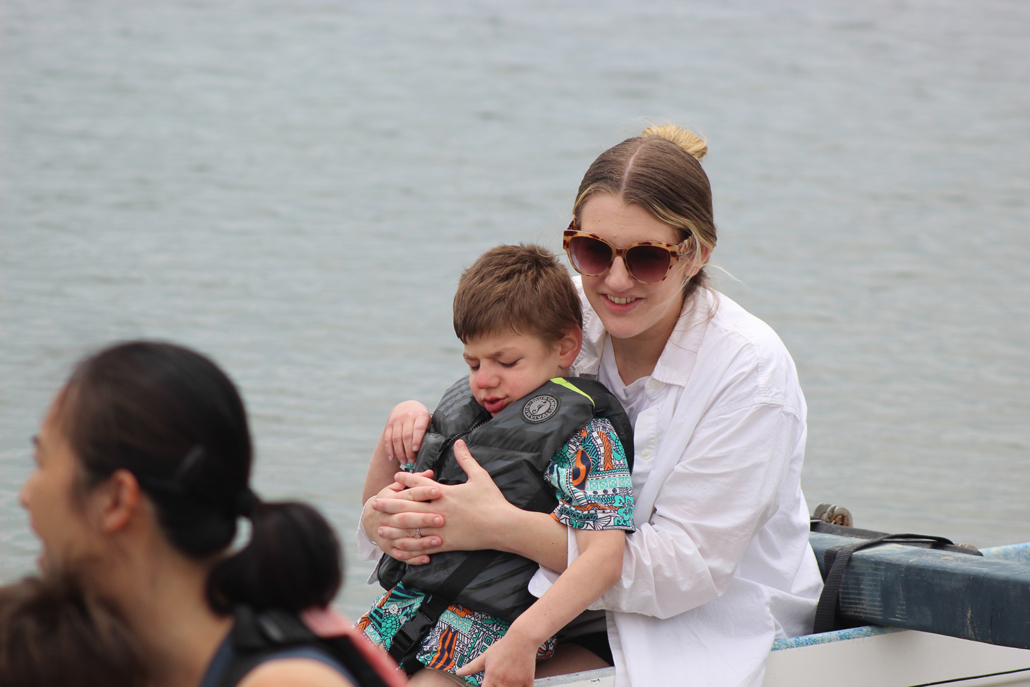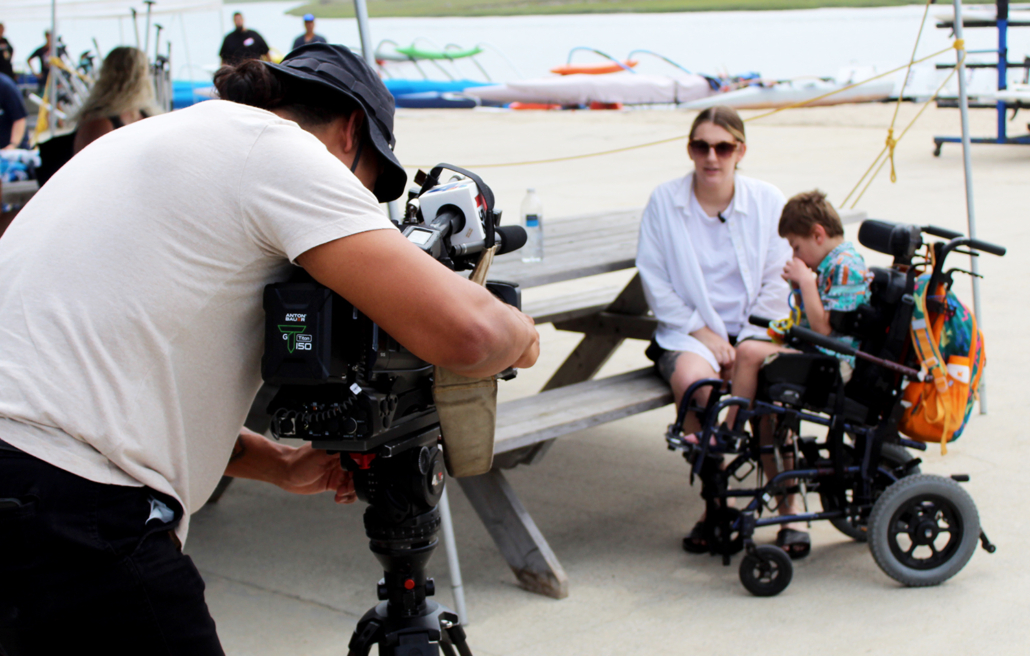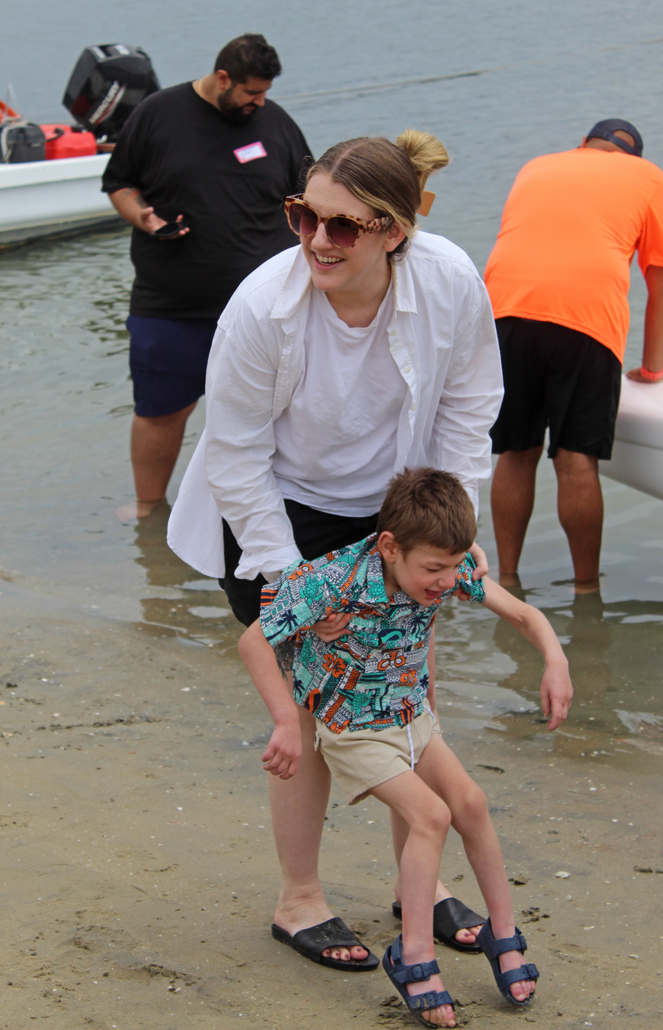Newport Aquatic Center Welcomes Beyond Blindness for an Inclusive Summer Camp Outrigger Outing
By Guest Contributor Jasmine Jenkins – August 11, 2024
Source: Newport Beach Independent https://www.newportbeachindy.com/newport-aquatic-center-welcomes-beyond-blindness-for-an-inclusive-summer-camp-outrigger-outing/
On August 1, the Newport Aquatic Center welcomed Beyond Blindness, a nonprofit in Santa Ana providing support for visually impaired children and their families, to their facility as part of Beyond Blindness’ inclusive summer camp, taking the campers on outriggers in the Back Bay.
This six-year partnership through the NAC’s Makapo program provides the opportunity for the children to play in the water with the proper accommodation.
Makapo is the name of the NAC’s outrigger paddling program for those with disabilities, named for the Hawaiian words maka (eye) and po (night).

Kristin McKay and her son, Charlie, aboard the outrigger canoe. Photo by Chris Trela
The project began in 2006 when a group of five blind men, under coach Billy Whitford, became the first all-blind team to complete the Queen Liliu’okalani Outrigger Canoe race in Hawaii. Whitford, now the executive director of the NAC, continues to support disabled athletes and community members through his work.
He asserted that Makapo is “absolutely one of our top programs because of what the place was built for: to give back to the community.”
“It’s unbelievably humbling,” said Whitford about the Beyond Blindness partnership. “It’s rewarding, yes, but it’s just so humbling to be able to help the kids and to show them that there’s so many opportunities out there for special needs kids. All you gotta do is look at their faces, look at the parents. Everybody is so happy. The vibe is so cool when these programs are down here.”
The inclusive summer camp is only one of many services Beyond Blindness offers for visually impaired children. Between infant/toddler classrooms, a preschool program, various therapies, and even a teen social group, Beyond Blindness offers comprehensive care for people with a wide range of disabilities.
According to Jacob Garcia, family support associate and teacher of the visually impaired at Beyond Blindness, “The Beyond Blindness inclusive summer camp provides children with a unique opportunity to participate in activities they might not typically engage in. They are also able to participate in a safe and inclusive environment that promotes their confidence and independence.”
Ashley Yee, MSW, director of family support at Beyond Blindness, said the inclusive Summer Camp has a positive impact on children with visual impairments and their families.
“The camp provides a space for families to send their kids to enjoy a typical camp experience with inclusive and accessible activities,” said Yee. “The kids can also interact with other peers who share similar challenges and opportunities. The camp helps them develop confidence and social skills in a fun and supportive environment. We design our activities with tactile and sensory elements that enable the participation of campers with different degrees of visual impairment and blindness.”
Kristin McKay, a Beyond Blindness board member and parent, spoke on her family’s experiences and how Beyond Blindness changed her son Charlie’s life. Charlie has a genetic disorder called Hunter syndrome along with cerebral palsy and cortical vision impairment, which is blindness caused by damage to the parts of the brain that process vision.

Kristin McKay, a Beyond Blindness board member and parent of Charlie, being interviewed about her family’s experiences. Photo by Chris Trela
When the McKays lived in Orange County, Charlie attended the Beyond Blindness daycare program. However, at that time, the preschool program was shut down due to COVID. The McKays moved to Los Angeles County, and just a month later, the preschool reopened.
“I was trying to go back to work, finally, and I had called around to all these places, all these daycares, preschools, everywhere, no one could take him,” explained Kristin. “Beyond Blindness was the only place that not only could take him but took care of him well and loved him.”

Kristin McKay helping her son, Charlie, get ready for his outrigger experience. Photo by Chris Trela
“A lot of–well really, all–preschools or daycares…they don’t have the staffing, they don’t have the knowledge, they don’t have the equipment, so they just say no” to children with more complex disabilities such as Charlie.
Left with nearly no other childcare options, Kristin drove 40 miles each way four times every day so that Charlie could attend the preschool in Santa Ana and receive the support he needed to thrive.
McKay shared how Charlie grew leaps and bounds from before they found Beyond Blindness to now. In the past, Charlie’s conditions prevented him from interacting with other people, but now “he loves being around other kids. He can interact with people in a different way than he used to be able to.”
She acknowledged that the Beyond Blindness staff also taught her to “challenge him and let him explore new things,” particularly in the way that they adapt activities to include all abilities.
She continued, “the world can accommodate my son, and he shouldn’t ever have to hear the word ‘no’ just because he has disabilities.”
About the Newport Aquatic Center, she was relieved that “they’ve done this before, they love making those accommodations, and they’re ready to go. They’re all set for all the kids because they’ve seen them before.”
For more information, visit https://newportaquaticcenter.com and https://www.beyondblindness.org.
By Guest Contributor Jasmine Jenkins – August 11, 2024
Source: Newport Beach Independent https://www.newportbeachindy.com/newport-aquatic-center-welcomes-beyond-blindness-for-an-inclusive-summer-camp-outrigger-outing/
Share this entry
Chairman Murray and Members of the Santa Ana Regional Water Quality Control Board:
My name is Dennis Durgan and I serve as Chairman of the Newport Harbor Foundation. The Foundation was founded in 2019 for the purpose of preserving, protecting and enhancing Newport Harbor for the benefit of the City of Newport Beach, the homeowners on or near the bay, the commercial operators in the bay, and the recreational users of the bay. The Foundation’s founders, contributors, and members are made up of individuals and business who have a long history of using and enjoying the harbor and a vested interest in its enhancement and preservation for use by current and future generations. On behalf the Foundation and its Board of Directors, I am reaching out to you to express our support for the currently pending project for dredging of Newport Harbor and construction of the confined aquatic disposal (CAD) site.
Hello friends of the Newport Harbor Foundation,
There is an urgent issue we need a little help with… something that impacts one of our favorite local playgrounds – the Newport Harbor.
After years of lobbying the federal government for help, the City of Newport Beach has obtained grants of almost $16 million to pay for dredging of the harbor which will significantly enhance the quality of water and create safer boat passage in the harbor. Along with the dredging process, there is a process called CAD (contained aquatic disposal) which places unsuitable material now existing in the harbor into a safe and secure location deep below the harbor bed. This process is totally safe and has been used for many years all over the country, including harbors in California.
By Phillip Palmer
ABC Eyewitness News, Los Angeles
NEWPORT BEACH, Calif. (KABC) — Keeping garbage out of the ocean isn’t easy. So enter Mr. Trash Wheel, the 70-square-foot barge gobbling up garbage by the ton to keep the beach and ocean pristine.
Trash in the streets ends up in the river and then from the river, the ocean.
Hoping to reduce the amount of trash making it to the ocean, Newport Beach is set to become the first west coast city to use a water wheel system to scoop up trash headed toward Upper Newport Bay.
“We really need to knock that trash load down. This is not going to be a silver bullet, it’s not going to get everything, but it’s going to get a big slug of stuff,” said John Kappeler, a senior engineer for the city of Newport Beach.



Leave a Reply
Want to join the discussion?Feel free to contribute!